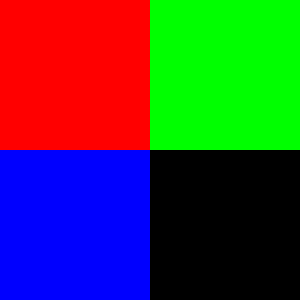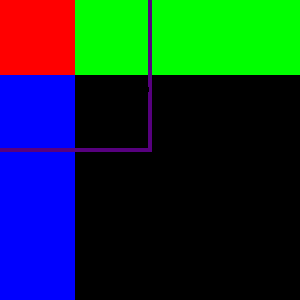Texture fetching#
Textures are more than just a buffer interpreted as a 1D, 2D, or 3D array.
As textures are associated with graphics, they are indexed using floating-point values. The index can be in the range of [0 to size-1] or [0 to 1].
Depending on the index, texture sampling or texture addressing is performed, which decides the return value.
Texture sampling: When a texture is indexed with a fraction, the queried value is often between two or more texels (texture elements). The sampling method defines what value to return in such cases.
Texture addressing: Sometimes, the index is outside the bounds of the texture. This condition might look like a problem but helps to put a texture on a surface multiple times or to create a visible sign of out-of-bounds indexing, in computer graphics. The addressing mode defines what value to return when indexing a texture out of bounds.
The different sampling and addressing modes are described in the following sections.
Here is the sample texture used in this document for demonstration purposes. It is 2x2 texels and indexed in the [0 to 1] range.

Texture used as example#
Texture sampling#
Texture sampling handles the usage of fractional indices. It is the method that describes, which nearby values will be used, and how they are combined into the resulting value.
The various texture sampling methods are discussed in the following sections.
Nearest point sampling#
In this method, the modulo of index is calculated as:
tex(x) = T[floor(x)]
This is also applicable for 2D and 3D variants.
This doesn’t interpolate between neighboring values, which results in a pixelated look.
The following image shows a texture stretched to a 4x4 pixel quad but still indexed in the [0 to 1] range. The in-between values are the same as the values of the nearest texel.

Texture upscaled with nearest point sampling#
Linear filtering#
The linear filtering method does a linear interpolation between values. Linear
interpolation is used to create a linear transition between two values. The
formula used is (1-t)P1 + tP2 where P1 and P2 are the values and
t is within the [0 to 1] range.
In the case of texture sampling the following formulas are used:
For one dimensional textures:
tex(x) = (1-α)T[i] + αT[i+1]For two dimensional textures:
tex(x,y) = (1-α)(1-β)T[i,j] + α(1-β)T[i+1,j] + (1-α)βT[i,j+1] + αβT[i+1,j+1]For three dimensional textures:
tex(x,y,z) = (1-α)(1-β)(1-γ)T[i,j,k] + α(1-β)(1-γ)T[i+1,j,k] + (1-α)β(1-γ)T[i,j+1,k] + αβ(1-γ)T[i+1,j+1,k] + (1-α)(1-β)γT[i,j,k+1] + α(1-β)γT[i+1,j,k+1] + (1-α)βγT[i,j+1,k+1] + αβγT[i+1,j+1,k+1]
Where x, y, and, z are the floating-point indices. i, j, and, k are the integer
indices and, α, β, and, γ values represent how far along the sampled point is on
the three axes. These values are calculated by these formulas: i = floor(x'), α = frac(x'), x' = x - 0.5, j = floor(y'), β = frac(y'), y' = y - 0.5, k = floor(z'), γ = frac(z') and z' = z - 0.5
This following image shows a texture stretched out to a 4x4 pixel quad, but still indexed in the [0 to 1] range. The in-between values are interpolated between the neighboring texels.

Texture upscaled with linear filtering#
Texture addressing#
Texture addressing mode handles the index that is out of bounds of the texture. This mode describes which values of the texture or a preset value to use when the index is out of bounds.
The following sections describe the various texture addressing methods.
Address mode border#
In this method, the texture fetching returns a border value when indexing out of bounds. The border value must be set before texture fetching.
The following image shows the texture on a 4x4 pixel quad, indexed in the [0 to 3] range. The out-of-bounds values are the border color, which is yellow.

Texture with yellow border color.#
The purple lines are not part of the texture. They only denote the edge, where the addressing begins.
Address mode clamp#
This mode clamps the index between [0 to size-1]. Due to this, when indexing out-of-bounds, the values on the edge of the texture repeat. The clamp mode is the default addressing mode.
The following image shows the texture on a 4x4 pixel quad, indexed in the [0 to 3] range. The out-of-bounds values are repeating the values at the edge of the texture.

Texture with clamp addressing#
The purple lines are not part of the texture. They only denote the edge, where the addressing begins.
Address mode wrap#
Wrap mode addressing is only available for normalized texture coordinates. In this addressing mode, the fractional part of the index is used:
tex(frac(x))
This creates a repeating image effect.
The following image shows the texture on a 4x4 pixel quad, indexed in the [0 to 3] range. The out-of-bounds values are repeating the original texture.

Texture with wrap addressing.#
The purple lines are not part of the texture. They only denote the edge, where the addressing begins.
Address mode mirror#
Similar to the wrap mode the mirror mode is only available for normalized texture coordinates and also creates a repeating image, but mirroring the neighboring instances.
The formula is the following:
tex(frac(x)), if floor(x) is even,
tex(1 - frac(x)), if floor(x) is odd.
The following image shows the texture on a 4x4 pixel quad, indexed in The [0 to 3] range. The out-of-bounds values are repeating the original texture, but mirrored.

Texture with mirror addressing#
The purple lines are not part of the texture. They only denote the edge, where the addressing begins.